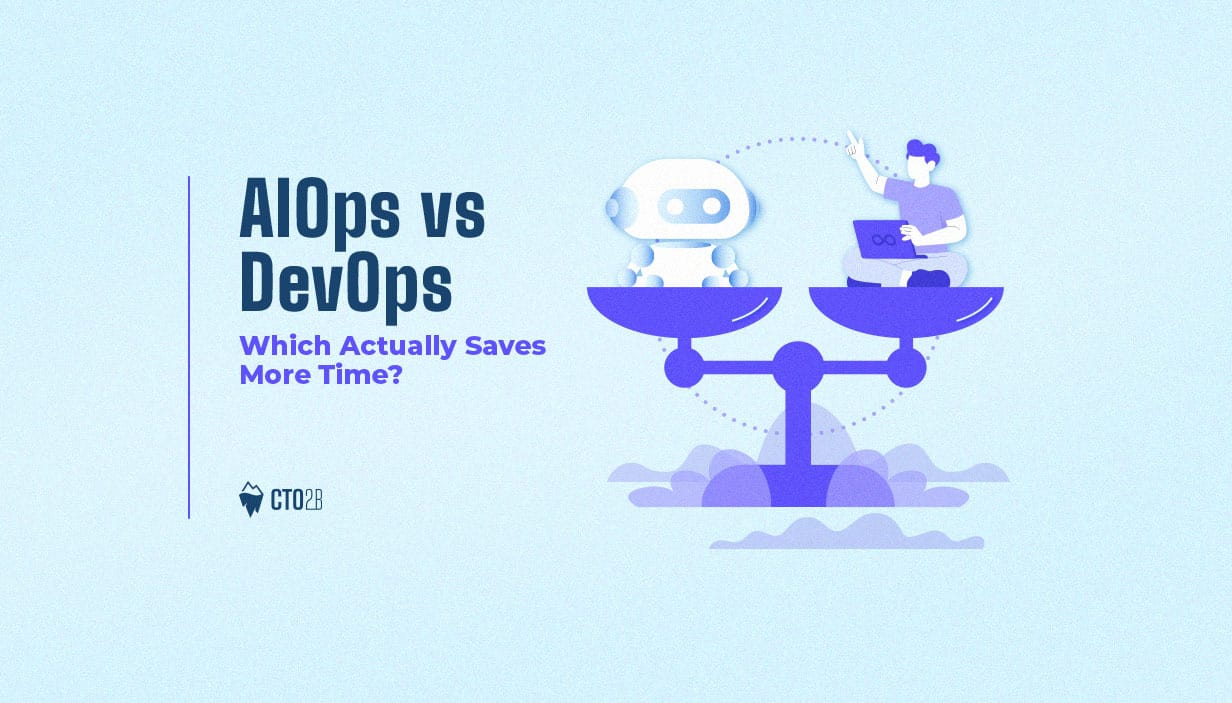In modern IT environments, where operational complexity and business demands are constantly growing, efficiency is no longer optional, it’s essential. Two approaches dominate the conversation: AIOps vs DevOps. Both promise to streamline IT operations, improve collaboration, and accelerate the software development lifecycle, but which one truly saves more time?
DevOps, a term first coined by Patrick Debois in 2008, reshaped the software delivery landscape by bringing development and operations teams together. By breaking down silos, improving communication, and embracing DevOps principles such as continuous integration and continuous delivery, it enabled organizations to achieve reliable software releases at higher speed.
AIOps, which emerged in the early 2010s and was popularized by Gartner in 2016, took automation further by embedding artificial intelligence and machine learning models directly into IT operations. Instead of simply automating known workflows, it applies predictive analytics, anomaly detection, and event correlation to vast datasets from across the IT ecosystem, delivering actionable insights that optimize operational workflows, enhance system reliability, and reduce manual intervention.
Understanding their differences, and how they can work together, is crucial for IT teams aiming for maximum time savings without compromising quality.
Key Takeaways
- DevOps excels through collaboration: Creates streamlined workflows by uniting development and operations teams with shared accountability and CI/CD automation.
- AIOps delivers dramatic automation gains: Reduces incident management time by 78% and alert triage workload by 90% through AI-driven predictive analytics and intelligent automation.
- Integration maximizes time savings: Organizations combining both approaches gain 30–50% faster deployment cycles while maintaining DevOps’ collaborative culture.
- Context determines optimal choice: DevOps suits process optimization needs, while AIOps addresses complex troubleshooting, data quality challenges, and infrastructure provisioning issues.
Understanding DevOps and AIOps
Although AIOps vs DevOps discussions often happen in the same breath, they are distinct methodologies with different focuses in the modern IT landscape.
DevOps: Collaboration between development and operations
DevOps was born out of a need to solve a fundamental disconnect: developers worked in isolation from operations engineers. This siloed structure meant developers had little awareness of production challenges, while operations teamswere often blindsided by new code and new feature deployments.
By uniting development and operations, DevOps fosters better collaboration and shared responsibility across the software development lifecycle. Both development teams and ops gain end-to-end visibility into the deployment processes, version control changes, and the software delivery pipeline.
While DevOps does not inherently depend on automation, embracing automation has become central to its devops implementation. Tools enabling continuous integration, continuous delivery, and infrastructure as code help standardize workflows and ensure reliable software releases. These devops practices improve developer experience devops by reducing manual effort and enabling faster feedback loops.
AIOps: AI-driven automation for IT operations
AIOps, short for “Artificial Intelligence for IT Operations”, takes automation to another level. It integrates machine learning models, advanced analytics, and big data into daily IT operations, fundamentally changing operational workflows.
AIOps systems continuously collect performance data from across the IT environment, including infrastructure, cloud services, application performance metrics, and logs, and run data pipelines to aggregate, clean, and analyze it. This enables anomaly detection, root cause analysis, and predictive analytics without the constant human oversightrequired in traditional devops processes.
The benefits of AIOps include proactive problem prevention, data quality improvements, and intelligent resource allocation. By removing repetitive tasks and enabling real-time insights, AIOps can dramatically reduce operational costs and improve system performance.
Shared Goals but Different Approaches
Both AIOps and DevOps aim to make the software development process faster, more predictable, and more reliable. They share a commitment to automation and continuous improvement, but their methods differ.
DevOps focuses on process optimization, better team structure, and shared ownership to eliminate inefficiencies between individual teams. AIOps applies intelligent automation to massive datasets, uncovering patterns and responding in real time to potential problems.
Rather than replacing DevOps, AIOps complements it, making DevOps operations smarter, faster, and more resilient. Organizations that successfully combine the two can achieve higher efficiency, improved application performance, and a measurable competitive edge in their markets.
Core Functional Differences
Automation Scope: DevOps uses human-triggered, predefined automation scripts. While effective for standard processes, these require human intervention when something unexpected happens. AIOps’ automation is adaptive, machine learning workflows allow the system to detect and address issues dynamically without waiting for operator commands.
Monitoring Tools: Traditional DevOps relies on rule-based monitoring, thresholds and triggers set manually. AIOps uses predictive analytics to analyze vast datasets and forecast potential failures before they occur, enhancing system reliability.
Incident Management: DevOps is reactive, fixing problems after they occur. AIOps is proactive, predicting and preventing issues via continuous data collection and performance optimization.
Alert Handling: DevOps requires manual triage, which can overwhelm teams. AIOps uses event correlation and AI-powered noise reduction to filter, group, and prioritize alerts automatically.
Time-Saving Capabilities Compared
When comparing AIOps and DevOps on pure time savings, their approaches are distinct:
Deployment Speed: DevOps accelerates deployments through continuous integration and continuous delivery CI/CD frameworks, merging code changes into a central repository and automating tests. AIOps adds self-healing pipelines, where AI detects anomalies, references historical data, and takes corrective action instantly.
Issue Resolution Time: Traditional DevOps relies on manual intervention for debugging and incident management. AIOps automates root cause analysis, reducing resolution time by up to 78% without sacrificing product quality.
Scalability Management: DevOps scaling is manual and often based on experience. AIOps uses predictive analytics to forecast demand and adjust resources in real time, optimizing cloud infrastructure and cutting cloud costs by up to 35%.
Alert Fatigue: DevOps teams manually sift through alerts, risking on call burden and burnout. AIOps reduces alert workload by 90%, enabling better collaboration and focus on meaningful tasks.
AIOps and DevOps Work Better Together
Industry research shows that the most effective organizations merge the core principles of DevOps with the intelligence for its operations that AIOps delivers. DevOps provides a strong foundation of process optimization and shared ownership, while AIOps augments these with real-time actionable insights, performance optimization, and automated decision-making.
Integrating AIOps into a DevOps pipeline adds end to end visibility across the software development lifecycle, improves deployment cycles, and boosts the developer experience DevOps by removing tedious, error-prone tasks.
Comparison Table
| Aspect | DevOps | AIOps |
| Core Approach | Unites development and operations teams through collaboration | Uses AI and machine learning to optimize IT operations |
| Automation Type | Manually triggered automation with predefined scripts | Self-learning systems with minimal human input |
| Monitoring Method | Rule-based systems with predefined thresholds | Predictive analytics with pattern recognition |
| Incident Management | Reactive “wait-and-fix” approach | Proactive prevention through continuous monitoring |
| Alert Handling | Manual prioritization by human operators | AI-powered automatic alert triage and correlation |
| Resolution Time | Traditional manual debugging required | 78% faster resolution (from 25 to 5.5 hours per incident) |
| Resource Management | Manual scaling based on human planning | Predictive resource allocation (20-35% reduction in cloud costs) |
| Alert Workload Reduction | Subject to alert fatigue and backlogs | 90% reduction in alert triage workload |
| Deployment Speed | Traditional CI/CD pipelines | 30-50% faster cycle times with self-healing pipelines |
How CTO2B Helps Organizations Combine AIOps and DevOps for Maximum Efficiency
At CTO2B, we understand that many growing engineering organizations face immense pressure to scale without bloating operational costs. Our platform is built on the belief that devops combines best-in-class collaboration with the intelligence of aiops platforms.
We give engineering organizations ready-to-use, secure, and fully managed infrastructure provisioning tools that integrate seamlessly with both DevOps services and implementing AIOps strategies. From continuous delivery CI/CD pipelines to performance data monitoring and root cause analysis, we enable development and operations teams to work as one, supported by AI-driven insights that improve system reliability and customer satisfaction.
Whether your mid sized team needs to scale DevOps without hiring more, improve data quality, or optimize cloud costs, CTO2B’s unified platform delivers the automation tools and operational workflows to make it happen without sacrificing product market fit or engineering excellence.
The future belongs to integration rather than choosing sides. DevOps teams incorporating AI capabilities into workflows create the most effective path toward operational efficiency. Teams embracing both methodologies benefit from process-oriented DevOps foundations amplified by intelligent AIOps automation capabilities.
Ready to optimize your IT operations? Contact us to discover which approach delivers maximum time savings for your specific needs.
FAQs
Is AIOps replacing DevOps in modern IT operations?
No, AIOps is not replacing DevOps. Instead, it’s enhancing DevOps practices by integrating AI capabilities to automate complex tasks, improve efficiency, and provide predictive insights. Many organizations are adopting a hybrid approach that combines the collaborative culture of DevOps with the intelligent automation of AIOps.
How relevant will DevOps be in 2025?
DevOps will remain highly relevant in 2025. The job market for DevOps professionals is expected to continue growing, offering numerous opportunities and competitive salaries. DevOps principles of collaboration and continuous improvement will still be crucial for efficient software development and IT operations.
What are the key differences between DevOps and AIOps?
DevOps focuses on uniting development and operations teams through collaboration and shared processes, while AIOps leverages artificial intelligence to optimize IT operations. DevOps relies more on manually triggered automation, whereas AIOps employs AI-driven workflows and predictive analytics for proactive issue resolution and resource management.
How does AIOps impact incident resolution times?
AIOps significantly reduces incident resolution times. Organizations implementing AI-powered root cause analysis have seen their mean-time-to-resolution drop by 78%, from 25 hours to just 5.5 hours per incident. AIOps systems can identify critical alert causes within 30 seconds, enabling faster issue resolution.
What future developments can we expect in AIOps?
The future of AIOps involves enhanced integration with Business Intelligence capabilities, providing more advanced analytics and predictive features. This convergence will enable IT teams to make data-driven decisions based on actionable insights derived from vast amounts of operational data, further streamlining IT operations and improving overall business efficiency.


